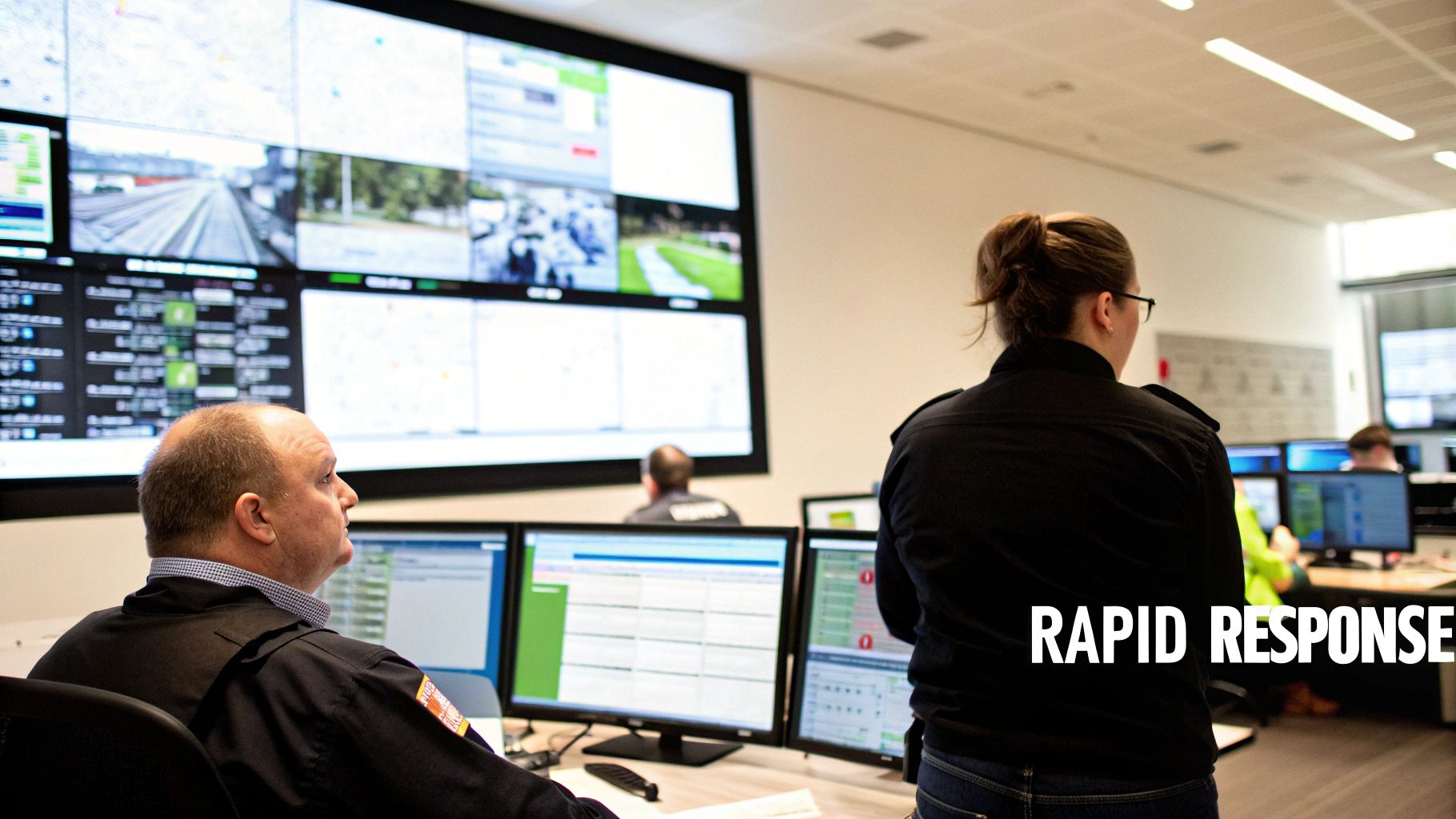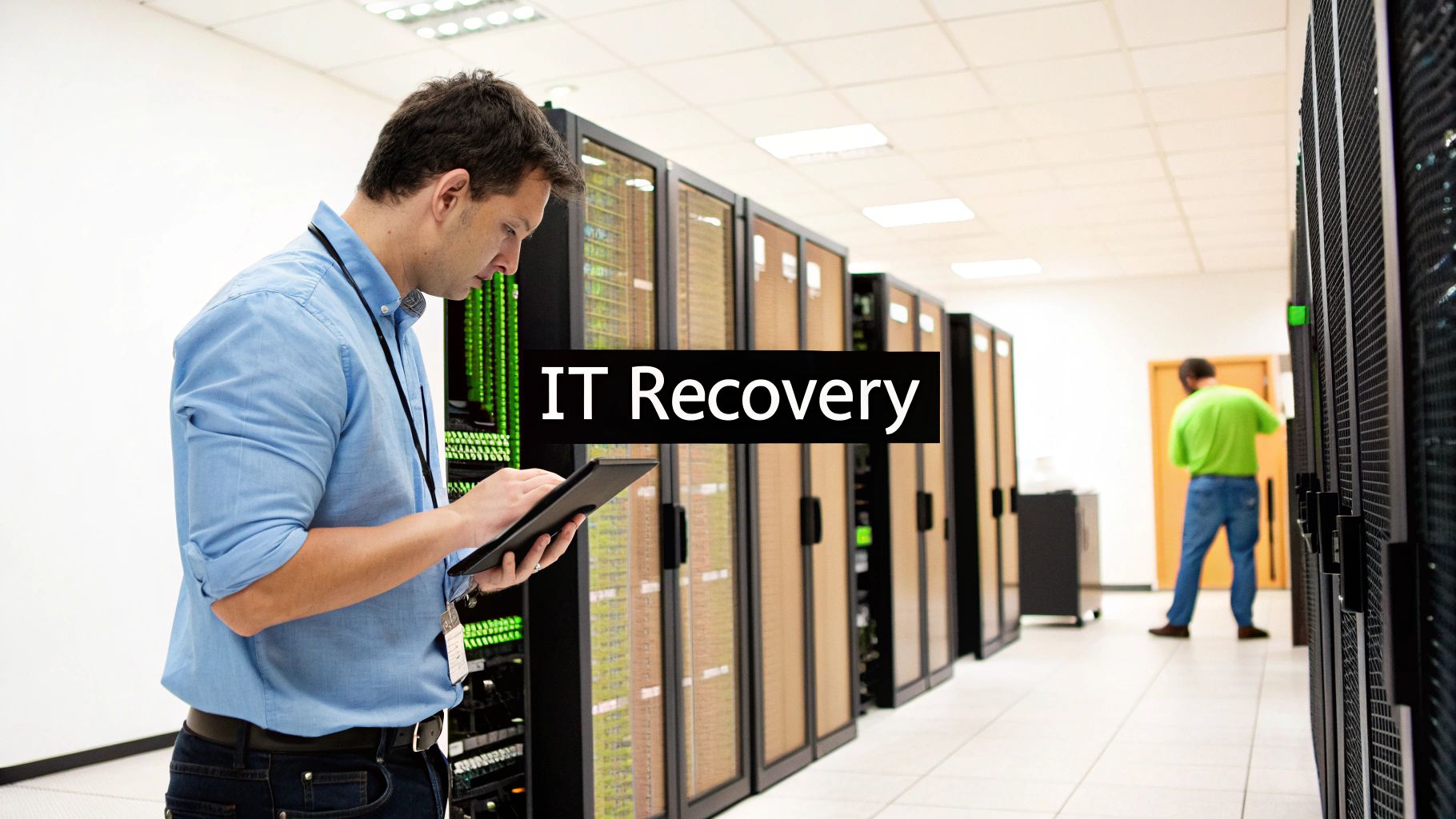Safeguarding Your Business: A Critical Need for 2025
Disruptions can cripple any business. This business continuity plan checklist provides the essential steps to safeguard your operations. From risk assessment to vendor continuity, this list covers ten crucial areas to build a robust business continuity plan (BCP). Learn how to develop emergency procedures, ensure IT disaster recovery, maintain supply chain resilience, and implement effective communication strategies. This checklist empowers startups, small businesses, freelancers, BPO providers, corporate offices, and co-working spaces alike to prepare for and navigate potential disruptions in 2025 and beyond.
1. Risk Assessment and Business Impact Analysis
A robust business continuity plan checklist must begin with a thorough Risk Assessment and Business Impact Analysis (BIA). This crucial first step forms the bedrock of any effective BCP by identifying potential disruptions to your operations and analyzing their impact on essential business functions. This methodical approach allows organizations of all sizes, from startups and freelancers to large corporate offices and BPO providers, to strategically allocate resources based on the severity of potential threats and ensure business survival. This proactive strategy is essential for any organization looking to build resilience and safeguard its future.

The BIA process involves systematically identifying critical business processes and their dependencies, evaluating the potential quantitative (financial) and qualitative (operational) impact of various disruptions, and determining the acceptable Recovery Time Objective (RTO) and Recovery Point Objective (RPO) for each process. Comprehensive threat modeling, encompassing natural disasters, cyberattacks, pandemics, and even internal failures, provides a holistic view of potential vulnerabilities.
Features of a Robust Risk Assessment and BIA:
- Identification of Critical Business Processes and Dependencies: Pinpointing core processes crucial for daily operations and understanding how different departments and systems rely on each other.
- Quantitative and Qualitative Impact Evaluation: Assessing potential disruptions in terms of financial losses (e.g., lost revenue, recovery costs) and operational impacts (e.g., reputational damage, customer churn).
- Recovery Time Objective (RTO) and Recovery Point Objective (RPO) Determination: Defining the maximum acceptable downtime for each process and the maximum acceptable data loss in the event of a disruption.
- Comprehensive Threat Modeling: Identifying and analyzing a wide range of potential threats, from natural disasters and cyberattacks to supply chain disruptions and human error.
Pros:
- Data-Driven Prioritization: Provides a clear, data-driven framework for prioritizing recovery efforts based on potential impact.
- Investment Justification: Helps justify BCP investment to leadership by demonstrating the potential financial and operational consequences of disruptions.
- Vulnerability Awareness: Creates a clear understanding of organizational vulnerabilities, allowing for proactive mitigation strategies.
- Measurable Recovery Metrics: Establishes measurable recovery metrics (RTO and RPO) to guide recovery planning and execution.
Cons:
- Resource Intensive: Conducting a thorough BIA can be time-consuming and require significant resources.
- Regular Updates Required: Business processes evolve, so the BIA needs regular updates to remain relevant.
- Uncomfortable Revelations: The process may reveal uncomfortable truths about organizational vulnerabilities and weaknesses.
- Prediction Challenges: Accurately predicting the full impact of all potential scenarios can be challenging.
Examples of Successful Implementation:
- JPMorgan Chase's comprehensive annual enterprise-wide BIA proved invaluable during the 2008 financial crisis, enabling them to quickly adapt and maintain operations.
- Toyota's supply chain vulnerability analysis after the 2011 Tōhoku earthquake and tsunami led to significant improvements in supply chain resilience.
Actionable Tips for Conducting a BIA:
- Involve Department Heads: Engage department heads to ensure accurate process mapping and impact assessment.
- Use Historical Data and Forward-Looking Analysis: Combine historical data on past incidents with forward-looking analysis to identify potential future threats.
- Consider Interdependencies: Analyze interdependencies between departments and systems to understand the cascading effects of disruptions.
- Regular Updates: Update the BIA at least annually or after significant operational changes.
- Quantify Impacts: Quantify potential impacts in financial terms wherever possible to demonstrate the business case for BCP investment.
Why This Item Deserves Its Place in the Business Continuity Plan Checklist:
The Risk Assessment and BIA provides the foundational knowledge required for all subsequent steps in the BCP process. Without a clear understanding of potential threats and their impact, organizations cannot effectively prioritize resources, develop recovery strategies, or ensure business continuity. This process is crucial for startups, small businesses, freelancers, BPO providers, corporate offices, and plug-and-play businesses alike. By understanding their vulnerabilities and potential impacts, businesses can make informed decisions to build resilience and protect their operations. The BIA process is popularized by organizations such as the Disaster Recovery Institute International (DRII), the Business Continuity Institute (BCI), and the ISO 22301 standard, highlighting its importance in the field of business continuity management.
2. Emergency Response and Crisis Management Procedures
A crucial component of any robust business continuity plan checklist is the inclusion of Emergency Response and Crisis Management Procedures. This strategy focuses on the immediate response to disruptive incidents, such as natural disasters, cyberattacks, or public health crises, by establishing clear protocols for crisis management teams and emergency response. It provides a structured approach to handling the initial phases of an incident before recovery procedures are activated. This proactive approach minimizes the impact of the disruption, protects employees, and safeguards business assets. A well-defined emergency response plan is essential for navigating the chaotic initial stages of a crisis and setting the stage for a smoother recovery.

This section of your business continuity plan checklist should outline the following key features: a clearly defined crisis management team structure, established notification and escalation procedures, predefined emergency response protocols, crisis communication templates and channels, and comprehensive emergency contact lists and calling trees. Learn more about Emergency Response and Crisis Management Procedures Having these components in place allows organizations of all sizes, from startups and freelancers to large BPO providers and corporate offices, to react swiftly and efficiently when disaster strikes.
The benefits of having robust Emergency Response and Crisis Management Procedures are numerous. They reduce panic and confusion during crises, ensuring a more measured and effective response. They also minimize response time in critical situations, allowing for quicker mitigation of damages. Furthermore, these procedures ensure coordinated action across the organization, preventing duplicated efforts and conflicting messages. Most importantly, these procedures prioritize human life and safety.
Consider the successful crisis management demonstrated by Johnson & Johnson in the 1982 Tylenol crisis, which set a new standard for corporate responsibility and communication during a crisis. More recently, Marriott's response to the 2018 data breach exemplified well-executed crisis communication, mitigating reputational damage. These examples highlight the value of a well-prepared approach.
While the advantages are clear, it's important to acknowledge the potential downsides. These procedures require regular training and simulation exercises to remain effective. They can also become outdated if not regularly reviewed and updated to reflect evolving threats and business operations. Coordination across multiple locations can present a challenge, requiring careful planning and communication strategies. Finally, even with the best plans, the effectiveness of the response ultimately depends on the individual decision-making of team members under stress.
To maximize the effectiveness of your Emergency Response and Crisis Management Procedures within your business continuity plan checklist, consider these actionable tips:
- Conduct tabletop exercises at least twice annually: This allows your team to practice their roles and identify potential weaknesses in the plan.
- Create role-specific emergency response cards: These provide quick access to critical information and procedures in a crisis.
- Test emergency notification systems regularly: Ensure your systems are functioning correctly and can reach all necessary personnel quickly.
- Train multiple backups for each crisis response role: This ensures continuity in case key personnel are unavailable.
- Include psychological support resources for affected staff: Crises can be traumatic, and providing support for employees is crucial for their well-being and recovery.
By incorporating these procedures and best practices into your business continuity plan checklist, you equip your organization to effectively navigate crises, minimizing their impact and ensuring a faster return to normal operations. This is paramount for organizations of all sizes, especially for startups, small businesses, freelancers, BPO providers, corporate offices, and plug-and-play businesses, all of whom can be significantly impacted by even minor disruptions.
3. IT Disaster Recovery Planning
IT Disaster Recovery Planning is a crucial component of any robust business continuity plan checklist. It focuses specifically on restoring your technology infrastructure and systems after an unforeseen disruption, such as a natural disaster, cyberattack, or even simple hardware failure. This planning ensures that your organization can recover its IT operations and data quickly and efficiently, allowing you to maintain essential business functions during and after a disruptive event. A well-defined IT disaster recovery plan is essential for minimizing downtime, protecting valuable data, and ensuring business resilience.

This element deserves a prominent place on your business continuity plan checklist because it addresses the core of modern business operations: technology. For startups, small businesses, freelancers, BPO providers, corporate offices, and plug-and-play setups alike, the ability to quickly restore IT systems and data is paramount for survival and continued operation. Without a plan, even a short disruption can lead to significant financial losses, reputational damage, and even legal repercussions, especially concerning data protection regulations. Learn more about IT Disaster Recovery Planning.
Key features of a comprehensive IT disaster recovery plan include:
- System Prioritization: Identify and prioritize systems based on their criticality to business operations. This ensures that the most vital systems are restored first.
- Detailed Backup and Restoration Procedures: Outline specific procedures for backing up and restoring data, applications, and operating systems. These should include step-by-step instructions and clearly defined roles and responsibilities.
- Alternative Processing Facilities: Consider options like hot sites (fully equipped backup facilities), warm sites (partially equipped facilities), or cold sites (basic infrastructure requiring setup) to ensure business continuity in case the primary location is unusable.
- Network Redundancy Planning: Implement redundant network connections and infrastructure to minimize the impact of network outages.
- Cloud-Based Recovery Options: Leverage cloud services for data backup, application hosting, and disaster recovery. This can offer greater flexibility and scalability.
- Specific Recovery Time Objective (RTO) and Recovery Point Objective (RPO): Define the maximum acceptable downtime (RTO) and data loss (RPO) for each system, driving the recovery strategy and resource allocation.
Pros:
- Minimizes costly downtime of critical systems
- Protects data integrity and availability
- Provides clear guidance for technical recovery
- Supports compliance with data protection regulations
Cons:
- Can be expensive to implement and maintain
- Requires specialized technical expertise
- Technology changes may quickly outdated plans
- Testing complete recovery can disrupt normal operations
Examples of Successful Implementation:
- Netflix's Chaos Monkey: This approach intentionally introduces failures into the system to test its resilience and identify weaknesses in the recovery process.
- Capital One's Cloud-Based Disaster Recovery: Their transition to the cloud proved invaluable during the COVID-19 pandemic, enabling seamless remote work transition and demonstrating the effectiveness of cloud-based disaster recovery.
Actionable Tips:
- Implement automated backup verification to ensure backups are reliable.
- Document recovery procedures with detailed, step-by-step instructions.
- Test recovery procedures for critical systems at least quarterly.
- Consider geographic dispersion for backup systems to protect against regional disasters.
- Maintain offline backups as a last line of defense against ransomware and other cyber threats.
By including IT Disaster Recovery Planning in your business continuity plan, you proactively safeguard your organization against potential disruptions, ensuring its long-term viability and success.
4. Supply Chain Resilience Planning
A crucial component of any robust business continuity plan checklist is Supply Chain Resilience Planning. This strategy focuses on maintaining operations during unforeseen disruptions by ensuring the continuity of critical supplies, materials, and third-party services. It aims to identify and mitigate vulnerabilities within your supply chain that could severely impact your business operations during a crisis, whether it's a natural disaster, cyberattack, pandemic, or geopolitical instability. By proactively addressing potential weaknesses, you can minimize downtime, maintain customer service levels, and protect your bottom line. This is a vital element of any business continuity plan checklist, ensuring your organization can weather unexpected storms.

Supply chain resilience planning involves several key features:
- Supplier Risk Assessment and Diversification: Evaluate the financial stability, geographical location, and potential risks associated with each supplier. Diversifying your supplier base reduces reliance on single points of failure.
- Alternate Supplier Identification and Onboarding Procedures: Establish a pre-approved list of alternative suppliers and streamline the onboarding process to quickly switch sources if necessary.
- Inventory Management and Strategic Stockpiling: Maintain optimal inventory levels of critical materials and components, considering lead times and potential disruptions. Strategic stockpiling can provide a buffer during emergencies.
- Contract Requirements for Supplier BCPs: Include clauses in supplier contracts requiring them to have their own business continuity plans in place, ensuring they can also withstand disruptions.
- Transportation and Logistics Alternatives: Identify alternative transportation routes and logistics providers to mitigate disruptions in the delivery of goods and services.
- Supplier Performance Monitoring: Continuously monitor supplier performance and responsiveness to identify potential issues early on.
Pros:
- Reduces dependency on single-source suppliers: Minimizes the impact of a single supplier's failure.
- Ensures materials and services availability during disruptions: Maintains operational continuity during crises.
- Creates competitive advantage during industry-wide disruptions: Enables businesses to continue operating when competitors might be struggling.
- Improves overall supply chain visibility: Provides a clearer understanding of the entire supply chain network.
Cons:
- May increase procurement costs and complexity: Managing multiple suppliers can be more expensive and complex.
- Requires significant coordination with external parties: Building relationships and aligning plans with multiple suppliers takes time and effort.
- Can create inventory carrying cost increases: Stockpiling inventory ties up capital and incurs storage costs.
- Difficult to verify third-party preparedness: Ensuring that suppliers are truly prepared for disruptions can be challenging.
Examples of Successful Implementation:
- Cisco: Cisco's robust supplier resilience program, which included diversification and close collaboration with suppliers, helped them navigate the semiconductor shortages effectively.
- Procter & Gamble: P&G's "control tower" approach, providing real-time visibility into their supply chain, proved invaluable during the COVID-19 pandemic, enabling them to adapt quickly to disruptions.
Tips for Implementation:
- Map your complete supply chain beyond tier-1 suppliers: Understand dependencies beyond your immediate suppliers.
- Consider geopolitical risks in supplier selection: Factor in political instability and trade regulations.
- Negotiate BCP requirements in supplier contracts: Ensure your suppliers are also prepared for disruptions.
- Create joint response plans with critical suppliers: Develop collaborative strategies to address potential disruptions.
- Implement supplier diversification for critical components: Don't rely on a single source for essential items.
Why Supply Chain Resilience Planning Deserves its Place in the Business Continuity Plan Checklist:
For startups, small businesses, freelancers, BPO providers, corporate offices, and plug-and-play spaces alike, disruptions to the supply chain can be devastating. From delayed projects and lost revenue to reputational damage and even business closure, the consequences can be severe. Supply chain resilience planning is not a luxury, but a necessity for any business that relies on external suppliers. It provides the proactive measures needed to mitigate risks and ensure continued operations, regardless of the source of the disruption. By including supply chain resilience in your business continuity plan checklist, you are taking a crucial step towards safeguarding your organization's future. While organizations like the Supply Chain Resilience Council, the Council of Supply Chain Management Professionals, and the MIT Center for Transportation & Logistics have popularized this concept, its importance resonates across all business sizes and industries.
5. Alternate Work Arrangements and Workforce Planning
A crucial component of any robust business continuity plan checklist is Alternate Work Arrangements and Workforce Planning. This strategy ensures business operations can continue even when normal working conditions are disrupted. It focuses on establishing alternative ways for employees to work, encompassing everything from physical workspace alternatives and remote work capabilities to cross-training and succession planning. This element is essential for maintaining productivity and minimizing downtime when unforeseen events impact the workplace.
This approach works by proactively addressing potential disruptions and preparing the workforce to adapt. Instead of relying solely on a traditional office setting, businesses establish systems and policies that allow for flexible working arrangements. This includes:
- Remote Work Infrastructure and Policies: Establishing secure and reliable systems for remote access, communication, and collaboration. Clear policies outlining expectations for remote work are also critical.
- Alternate Work Site Identification and Setup: Identifying and equipping backup work locations, ensuring they can accommodate essential personnel and operations if the primary site is inaccessible.
- Cross-training Programs for Critical Functions: Training employees to perform multiple roles within the organization. This ensures coverage for essential functions even if key personnel are unavailable.
- Succession Planning for Key Positions: Identifying and developing internal candidates to fill critical roles should a key employee depart unexpectedly. This minimizes disruption and ensures leadership continuity.
- Employee Emergency Communication Systems: Robust communication channels to quickly disseminate information to employees during emergencies, ensuring everyone stays informed and coordinated.
- Digital Collaboration Tools and Protocols: Providing access to and training on collaborative software and establishing clear protocols for their use, ensuring seamless teamwork regardless of location.
Why This Item Deserves Its Place in the Business Continuity Plan Checklist:
In today's dynamic environment, disruptions can arise from various sources, including natural disasters, pandemics, cyberattacks, and even simple infrastructure failures. Alternate work arrangements provide the flexibility and resilience needed to navigate these challenges. Without a well-defined plan, businesses risk significant productivity losses, financial setbacks, and reputational damage.
Examples of Successful Implementation:
- Salesforce: During the COVID-19 pandemic, Salesforce leveraged its own cloud-based collaboration tools to enable a rapid and seamless transition to remote work for its vast global workforce.
- American Express: Their "work-from-anywhere" model, developed as part of their business continuity plan, allowed them to adapt quickly to changing circumstances and maintain business operations.
Pros:
- Enables rapid transition to alternative working models.
- Reduces vulnerability to facility-specific disruptions.
- Improves overall organizational flexibility.
- Maintains productivity during various disruption scenarios.
Cons:
- Requires significant technology infrastructure investment.
- May create security vulnerabilities with distributed work.
- Can encounter resistance to cross-training initiatives.
- Potential productivity impacts during transition periods.
Actionable Tips:
- Test Your Systems: Implement regular remote work days to test the effectiveness of your remote work infrastructure and identify any weaknesses.
- Prioritize Cross-Training: Create skill matrices to identify cross-training priorities, focusing on essential functions.
- Prepare Remote Work Kits: Design role-specific remote work kits containing essential equipment and resources for rapid deployment.
- Mitigate Geographic Risks: Consider regional workforce distribution to reduce the impact of localized disruptions.
- Prioritize Security: Develop clear policies for remote work security, including data protection, access control, and device management.
When and Why to Use This Approach:
This approach is relevant for businesses of all sizes, from startups to large corporations, and across all industries. It is particularly crucial for businesses with:
- Critical Operations: Organizations where downtime can have significant financial or reputational consequences.
- Concentrated Workforce: Businesses with a large portion of their workforce located in a single location, increasing their vulnerability to localized disruptions.
- Customer-Facing Roles: Companies where customer service and interaction are essential for business continuity.
Popularized By:
Organizations like Global Workplace Analytics, the Society for Human Resource Management (SHRM), and Gallup Workplace research have extensively documented the importance and benefits of flexible work arrangements and their contribution to business continuity.
By incorporating Alternate Work Arrangements and Workforce Planning into your business continuity plan checklist, you are taking a proactive step towards building a more resilient and adaptable organization capable of weathering unforeseen challenges and maintaining operational effectiveness.
6. Data Backup and Protection Strategy
A robust data backup and protection strategy is a cornerstone of any effective business continuity plan checklist. This crucial element focuses on safeguarding critical business data through comprehensive backup protocols, data protection measures, and secure storage solutions. It ensures that organizations, from startups and freelancers to large corporate offices and BPO providers, can recover essential information following disruptions, maintaining data integrity and availability, and minimizing downtime. Without a solid data backup and protection strategy, businesses risk significant financial losses, reputational damage, and even permanent closure in the event of a disaster.
How it Works:
A comprehensive data backup and protection strategy typically employs a multi-layered approach. This involves creating multiple copies of your data, storing them on different media types, and ensuring at least one copy is located off-site. This commonly follows the 3-2-1 backup approach:
- 3 Copies: Maintain three separate copies of your data.
- 2 Different Media Types: Store these copies on two different types of media (e.g., local hard drive and cloud storage).
- 1 Off-Site Copy: Keep one copy off-site to protect against physical disasters affecting your primary location.
This strategy is further enhanced by features like automated backup scheduling and verification, data encryption for backups, immutable backup solutions (which protect against ransomware by preventing backups from being deleted or modified), granular recovery options (allowing restoration of specific files or folders), and data classification and prioritization.
Examples of Successful Implementation:
- Dropbox: In 2019, Dropbox avoided major data loss thanks to their multi-layered backup strategy, demonstrating the importance of redundancy and off-site backups.
- Slack: Their robust database redundancy system allowed for quick recovery during a significant outage in 2021, minimizing disruption to their millions of users.
Why This Approach is Essential for Business Continuity:
This item deserves its place in the business continuity plan checklist because data is the lifeblood of most modern businesses. Loss of critical data can cripple operations, leading to significant financial losses, legal liabilities, and irreparable damage to reputation. A well-defined data backup and protection strategy provides multiple recovery options for various scenarios, protecting against data loss from threats like hardware failure, human error, cyberattacks, and natural disasters. Furthermore, it helps ensure compliance with data protection regulations, which are increasingly stringent across various industries.
Pros:
- Provides multiple recovery options for different scenarios.
- Protects against data loss from various threats.
- Supports compliance with data protection regulations.
- Enables point-in-time recovery for specific incidents.
Cons:
- Can require significant storage infrastructure.
- May impact system performance during backup windows.
- Complex data environments can increase recovery complexity.
- Requires constant monitoring and management.
Actionable Tips:
- Test Restore Procedures Regularly: Don't just back up your data; regularly test your ability to restore it.
- Implement Air-Gapped Backups: For critical data, consider air-gapped backups, which are completely isolated from network connections, providing the ultimate protection against ransomware.
- Document Retention Requirements: Establish and document data retention requirements for different data types to comply with legal and regulatory obligations.
- Automate Backup Verification and Alerting: Automate the verification process and set up alerts for failed backups.
- Consider Zero Trust Security for Backup Systems: Implement zero trust principles to secure access to your backup systems, minimizing the risk of unauthorized access.
Popularized By:
- Veeam (backup software company)
- Backblaze (cloud backup provider)
- Storage Networking Industry Association (SNIA)
By prioritizing a comprehensive data backup and protection strategy within your business continuity plan, you are taking a proactive step towards safeguarding your valuable data, ensuring business resilience, and minimizing the impact of potential disruptions.
7. Business Continuity Testing and Exercises
A crucial component of any robust business continuity plan checklist is regular testing and exercises. This critical step, Business Continuity Testing and Exercises, validates the effectiveness of your plan, identifies potential weaknesses before a real disaster strikes, and ensures your team is prepared to respond effectively. Without regular testing, your meticulously crafted business continuity plan could be rendered useless in a real emergency.
This strategy involves running various types of tests, ranging from simple tabletop discussions to complex, full-scale simulations. These exercises allow you to evaluate your recovery procedures, train your personnel, and build the crucial muscle memory needed for effective crisis response.
How it Works:
A comprehensive business continuity testing program typically involves a tiered approach with escalating complexity:
- Scenario-based tabletop exercises: Teams walk through hypothetical disaster scenarios and discuss their responses, identifying potential gaps and refining procedures.
- Technical recovery testing: Focuses on the technical aspects of recovery, such as restoring data backups, testing failover systems, and verifying network connectivity.
- Full-scale simulation exercises: These simulate real-world disaster scenarios, involving all relevant personnel and systems. They provide the most realistic test of your plan's effectiveness.
Following each exercise, a thorough post-exercise evaluation is conducted to identify areas for improvement. These findings are documented, and the business continuity plan is updated accordingly. This continuous improvement cycle ensures your plan remains relevant and effective.
Examples of Successful Implementation:
- Goldman Sachs: Their commitment to quarterly BCP tests played a vital role in their ability to respond effectively during the 9/11 attacks, allowing them to quickly relocate operations and maintain business continuity.
- Bank of America: Their annual enterprise-wide recovery exercises simulate various regional disasters, ensuring their preparedness for a range of potential disruptions.
Why Include Testing and Exercises in Your Business Continuity Plan Checklist?
This element is non-negotiable for several reasons:
- Proactive Risk Management: Identifies plan weaknesses before actual disasters occur, saving you time, money, and reputation.
- Enhanced Preparedness: Builds team confidence and competence in recovery procedures.
- Compliance and Due Diligence: Demonstrates regulatory compliance and due diligence, which is particularly important for industries with strict regulatory requirements like financial institutions and BPO providers.
- Improved Response Times: Creates muscle memory for crisis response, leading to faster and more effective actions during a real event.
Pros:
- Identifies plan weaknesses before actual disasters occur
- Builds team confidence and competence in recovery procedures
- Demonstrates regulatory compliance and due diligence
- Creates muscle memory for crisis response
Cons:
- Can be disruptive to normal business operations
- Requires significant planning and resources
- May not fully simulate real-world complexity
- Exercise artificialities can create false confidence
Actionable Tips for Effective Testing:
- Start with simple tabletop exercises and gradually increase complexity.
- Include surprise elements to prevent scripted responses and test adaptability.
- Involve external stakeholders (e.g., vendors, clients) when appropriate for a more comprehensive test.
- Document lessons learned and update your business continuity plan accordingly.
- Rotate exercise leadership to build broad competency across the team.
When and Why to Use This Approach:
Business continuity testing should be a regular activity, not a one-time event. The frequency of testing will depend on the nature of your business, the regulatory environment, and the potential impact of disruptions. For startups, small businesses, freelancers, and even corporate offices within shared spaces like Plug and Play, regular testing, even on a smaller scale, can be the difference between surviving a disruption and going out of business.
Popularized By:
- FEMA's National Exercise Program
- DRI International's Professional Practices
- Federal Financial Institutions Examination Council (FFIEC)
By including Business Continuity Testing and Exercises as a core element in your business continuity plan checklist, you're investing in the resilience and longevity of your business. It's not just a best practice; it's a necessity for navigating today's increasingly complex and unpredictable business landscape.
8. Crisis Communication Planning
Crisis communication planning is a crucial component of any robust business continuity plan checklist. It outlines the strategies and procedures for communicating with all stakeholders during a disruptive event, such as a natural disaster, cyberattack, product recall, or public relations crisis. Effective crisis communication helps maintain trust, minimizes reputational damage, and facilitates a faster return to normal operations. Without a well-defined plan, organizations risk misinformation spreading, eroding stakeholder confidence, and prolonging the impact of the disruption. This is why it deserves a prominent place in your business continuity plan checklist.
How it Works:
Crisis communication planning involves establishing clear protocols for disseminating information to various stakeholders. This includes:
- Multi-channel communication capabilities: Utilizing diverse channels like email, SMS, website updates, social media, and press releases to reach the widest audience.
- Stakeholder mapping and prioritization: Identifying key stakeholders (employees, customers, suppliers, regulators, media, etc.) and prioritizing communication based on their importance and information needs.
- Pre-approved message templates for various scenarios: Developing pre-written messages for common crisis scenarios to ensure consistent and timely communication.
- Spokesperson designation and media training: Identifying and training designated spokespersons to handle media inquiries and deliver clear, concise messages.
- Social media monitoring and response procedures: Actively monitoring social media for mentions and conversations related to the crisis and implementing procedures for responding to inquiries and correcting misinformation.
- Internal and external communication coordination: Ensuring consistent messaging across all internal and external communication channels.
Examples of Successful Implementation:
- Delta Airlines (2016 System Outage): Delta's transparent communication regarding the cause and impact of their system outage, coupled with regular updates on restoration efforts, helped maintain customer loyalty despite significant disruption.
- Starbucks (2018 Racial Bias Incident): Starbucks' response to the racial bias incident, which involved closing stores for racial bias training and issuing a public apology, demonstrated accountability and a commitment to addressing the issue.
Actionable Tips:
- Establish a dark site: A dark site is a pre-built website that can be quickly activated during a crisis to provide essential information to stakeholders.
- Create message templates: Develop templates for the most likely crisis scenarios, addressing key information needs and incorporating consistent messaging.
- Train multiple spokespersons: Prepare multiple individuals to act as spokespersons, ensuring redundancy and expertise in different situations.
- Implement a rapid approval process for crisis messaging: Streamline the approval process to ensure timely release of information, especially during rapidly evolving situations.
- Develop relationships with media contacts before crises occur: Cultivate relationships with journalists and media outlets to facilitate communication during a crisis.
Pros:
- Reduces misinformation and rumor spread
- Maintains stakeholder confidence during disruptions
- Provides consistent messaging across all channels
- Supports faster operational recovery through clear communication
Cons:
- Requires rapid message approval processes that may be challenging
- Social media can quickly amplify messaging mistakes
- Different stakeholders may require conflicting messages
- Complex to manage in multi-national, multi-language organizations
When and Why to Use This Approach:
Crisis communication planning should be an integral part of every organization's business continuity plan. It should be utilized before, during, and after any disruptive event that impacts business operations or reputation. This proactive approach ensures that organizations are prepared to communicate effectively during a crisis, minimizing negative consequences and facilitating a swift recovery.
Popularized By: Public Relations Society of America (PRSA), Institute for Public Relations, Timothy Coombs (Situational Crisis Communication Theory)
This methodical approach to crisis communication is especially relevant for startups, small businesses, freelancers, BPO providers, corporate offices, and co-working spaces like Plug and Play, all of whom are susceptible to various disruptions that could impact their operations and reputation. By prioritizing crisis communication planning within your broader business continuity plan checklist, you can safeguard your organization’s stability and long-term success.
9. Compliance and Standard Alignment
A robust business continuity plan (BCP) isn't just about having a plan; it's about having a plan that works, stands up to scrutiny, and aligns with established best practices and regulatory requirements. This is where Compliance and Standard Alignment comes in. This crucial element of your business continuity plan checklist ensures that your BCP efforts meet relevant industry standards, regulatory obligations, and best practices. It provides a structured approach to business continuity, minimizing risks and maximizing preparedness.
This strategy involves benchmarking your BCP against recognized frameworks like ISO 22301, NIST standards, and industry-specific regulations (e.g., FFIEC for financial institutions, HIPAA for healthcare). By aligning with these standards, you demonstrate a commitment to resilience and due diligence. Learn more about Compliance and Standard Alignment
How it Works:
Compliance and Standard Alignment involves a systematic approach, often including:
- Gap Analysis: Identifying discrepancies between your current BCP and the chosen standards.
- Documentation Requirements Mapping: Ensuring your documentation fulfills the specific requirements of each standard.
- Regulatory Monitoring & Compliance Tracking: Staying updated on changes in regulations and tracking your compliance efforts.
- Audit Preparation Procedures: Establishing procedures for internal and external audits to verify compliance.
- Certification Processes: Pursuing certifications for applicable standards (e.g., ISO 22301) to demonstrate a high level of resilience.
- Compliance Reporting Mechanisms: Regularly reporting on compliance status to stakeholders.
Examples of Successful Implementation:
- A financial institution meticulously follows FFIEC guidelines for business continuity planning, ensuring it can maintain operations during a major disruption.
- A healthcare organization aligns its contingency planning with HIPAA requirements, safeguarding patient data and ensuring continued care in emergencies.
Why This Item Deserves Its Place in the Checklist:
In today's complex regulatory landscape, overlooking compliance can be disastrous. Compliance and Standard Alignment offers a proactive approach to mitigating legal and regulatory risks. It provides a structured framework, enhancing the comprehensiveness and effectiveness of your BCP. For businesses seeking a competitive edge, certifications like ISO 22301 can differentiate them in the marketplace and simplify third-party due diligence responses.
Pros:
- Provides structure and comprehensiveness to BCP efforts.
- Reduces legal and regulatory risks.
- Creates a competitive advantage through certification.
- Simplifies third-party due diligence responses.
Cons:
- Can become a checkbox exercise without genuine resilience if not implemented thoughtfully.
- Requires significant documentation and maintenance.
- Standards may lag behind emerging threats and technologies.
- Certification costs can be substantial.
Actionable Tips for Startups, Small Businesses, Freelancers, BPO Providers, Corporate Offices, and Plug and Play spaces:
- Focus on the spirit of the standards, not just the letter: Understand the underlying principles and adapt them to your specific context.
- Use maturity models: Progressively improve compliance over time, starting with the most critical aspects.
- Leverage automation: Automate compliance documentation and reporting where possible.
- Consider industry-specific frameworks beyond general standards: Tailor your approach to the unique risks and regulations of your sector.
- Participate in standards development organizations: Stay informed and contribute to the evolution of best practices.
When and Why to Use This Approach:
Compliance and Standard Alignment is essential for any organization that wants to ensure its business continuity plan is comprehensive, robust, and legally sound. It’s particularly crucial for businesses operating in regulated industries or those seeking a competitive edge through certification. Even for smaller businesses and freelancers, understanding and applying basic principles of these standards can significantly enhance resilience and preparedness. By incorporating this item into your business continuity plan checklist, you're laying the foundation for a more resilient and sustainable future.
10. Third-Party Risk Management and Vendor Continuity
Third-party risk management and vendor continuity is a critical component of any robust business continuity plan checklist. This strategy focuses on mitigating the risks associated with relying on external service providers and ensuring these vendors have adequate business continuity capabilities of their own. Overlooking this aspect can leave your organization vulnerable to disruptions stemming from issues impacting your vendors, not just internal incidents. This is why it deserves a prominent place in your business continuity plan checklist.
This process involves identifying potential disruptions to your vendors and developing strategies to mitigate their impact on your operations. This includes everything from natural disasters and cyberattacks affecting your vendors to more mundane issues like vendor bankruptcy or contract disputes. By proactively addressing these risks, you can maintain critical services even when circumstances beyond your direct control affect your partners.
Features of a strong third-party risk management and vendor continuity program:
- Vendor criticality assessment framework: Identify and categorize vendors based on their importance to your operations.
- Due diligence procedures for vendor BCPs: Review and assess the business continuity plans of critical vendors.
- Contract clauses for continuity requirements: Include specific continuity requirements in vendor contracts.
- Joint testing exercises with critical vendors: Conduct regular exercises to test the effectiveness of your joint continuity plans.
- Vendor diversification strategies: Reduce reliance on single vendors for critical services.
- Monitoring of vendor continuity capabilities: Regularly track and assess vendor performance and preparedness.
Pros:
- Reduces supply chain and service delivery vulnerabilities: Strengthens resilience against disruptions originating from external sources.
- Creates contractual leverage for vendor preparedness: Ensures vendors prioritize continuity and meet agreed-upon standards.
- Provides early warning of potential third-party issues: Proactive monitoring can reveal potential problems before they impact your operations.
- Aligns vendor capabilities with organizational requirements: Ensures vendors can support your business continuity objectives.
Cons:
- Limited visibility into actual vendor capabilities: Assessing the true effectiveness of vendor plans can be difficult.
- Challenging to enforce with dominant service providers: Negotiating favorable terms with large vendors can be difficult.
- Resource-intensive for organizations with many vendors: Implementing and maintaining a comprehensive program can require significant resources.
- Difficult to verify the effectiveness of vendor plans: Tabletop exercises and audits can help, but true effectiveness is only revealed during actual incidents.
Examples of Successful Implementation:
- Financial services firms requiring cloud providers to demonstrate business continuity capabilities through certifications, audits, and documentation.
- Manufacturing companies implementing vendor continuity scorecards and conducting regular reviews after experiencing supply chain disruptions. This allows them to proactively identify and address potential weaknesses.
Actionable Tips:
- Focus intensive management on your most critical vendors: Prioritize those vendors whose failure would have the most significant impact on your operations.
- Include right-to-audit clauses in vendor contracts: This allows you to verify vendor claims and ensure compliance with continuity requirements. When working with contractors, ensuring they maintain adequate insurance coverage is a crucial part of this process. A comprehensive contractor compliance checklist can help streamline this often complex task.
- Require vendors to notify you of their own disruptions: Establish communication protocols for timely notification of incidents affecting your vendors.
- Participate in vendor-led continuity exercises: Gain insights into vendor plans and identify potential gaps or weaknesses.
- Develop contingency plans for critical vendor failures: Identify alternative providers or develop internal workarounds in case a critical vendor is unable to deliver services.
When and Why to Use This Approach:
This approach is essential for any organization that relies on external vendors for critical services. It becomes increasingly important as your dependence on third-party providers grows. Implementing a robust third-party risk management and vendor continuity program should be a priority for any business looking to create a comprehensive business continuity plan checklist. Proactive planning and management can significantly reduce your vulnerability to external disruptions and ensure the continued delivery of essential services. By incorporating these strategies into your business continuity plan checklist, you are building a more resilient and adaptable organization.
Business Continuity Plan Checklist: 10 Key Elements Comparison
| Strategy | Complexity (🔄) | Resources (⚡) | Outcomes (📊) | Advantages (⭐) | Insights (💡) |
|---|---|---|---|---|---|
| Risk Assessment and Business Impact Analysis | High – In-depth threat modeling | High – Cross-department collaboration | Data-driven prioritization with measurable metrics | Clarifies vulnerabilities and defines recovery targets | Involve heads, update regularly |
| Emergency Response and Crisis Management Procedures | Medium – Structured yet evolving | Moderate – Requires regular training | Rapid, coordinated response minimizing confusion | Reduces panic and supports safe, quick action | Run tabletop exercises and maintain role-specific cards |
| IT Disaster Recovery Planning | High – Technically complex | High – Significant IT investments | Minimizes downtime and restores critical IT functions | Provides clear recovery procedures and compliance | Test frequently and update with technology changes |
| Supply Chain Resilience Planning | Medium – Coordination with external parties | Moderate to High – External vendor alignment | Ensures material and service continuity during disruptions | Reduces supplier dependency and increases visibility | Map the entire chain and diversify suppliers |
| Alternate Work Arrangements and Workforce Planning | Medium – Needs flexible policies | High – Investment in remote infrastructure | Maintains productivity despite facility disruptions | Enhances agility and rapid transition capability | Test remote work and focus on cross-training |
| Data Backup and Protection Strategy | Medium – Requires systematic protocols | High – Investment in storage and tech | Multiple recovery options safeguarding data integrity | Secures critical data against loss and cyber threats | Automate backups and test restore procedures regularly |
| Business Continuity Testing and Exercises | Medium – Iterative and evolving | Moderate – Planning and simulation efforts | Validates recovery plans and builds team readiness | Identifies weaknesses before real crises occur | Increase complexity gradually and document lessons |
| Crisis Communication Planning | Medium – Coordination intensive | Moderate – Utilizes multi-channel tools | Delivers timely, consistent messaging during incidents | Maintains stakeholder trust and limits misinformation | Pre-approve messages and train several spokespersons |
| Compliance and Standard Alignment | High – Documentation heavy | High – Continuous auditing and review | Creates structured, regulation-compliant BCP frameworks | Reduces legal risks and builds certification leverage | Leverage automation and focus on the spirit of standards |
| Third-Party Risk Management and Vendor Continuity | High – Involves extensive external assessment | High – Requires robust vendor monitoring | Mitigates external risks and sustains critical vendor services | Enhances oversight and contractual leverage | Focus on critical vendors and enforce contingency terms |
Building Resilience for a Secure Future
A comprehensive business continuity plan checklist, encompassing everything from risk assessment and business impact analysis to IT disaster recovery and supply chain resilience, is no longer a luxury but a necessity. This checklist provides a roadmap for navigating unforeseen disruptions, safeguarding your operations, and ensuring your business can weather any storm. Mastering these concepts, including robust data backup strategies, alternate work arrangements, and thorough testing and exercises, is paramount to maintaining business operations and minimizing downtime during critical events. By addressing potential vulnerabilities and establishing clear procedures for emergency response, crisis communication, and even third-party risk management, you build a foundation for long-term stability and success. This proactive approach not only protects your assets and reputation but also instills confidence in your clients, partners, and employees.
Implementing each item in the business continuity plan checklist empowers your organization to respond effectively to disruptions, minimize financial losses, and maintain essential services. The ability to adapt and recover quickly translates to a competitive advantage, ensuring business survival and fostering sustainable growth in a dynamic and often unpredictable marketplace.
Looking for a hassle-free way to enhance your business continuity plan? Explore how Seat Leasing BPO can support your resilience strategy by providing flexible and fully-equipped workspaces that seamlessly integrate with your disaster recovery plan. Visit Seat Leasing BPO today to learn more about their comprehensive workspace solutions and focus on your core business while they handle the backend complexities.




